Humour authors Scott Tulloch and Myles Lawford interview one another about their careers, and about their most recent books – Where’s Kiwi Now? for Lawford, and Keep an Eye on that Kiwi, for Tulloch. The two do quite different things within the medium of (mainly) picture books, and this piece gives great insight into how each of them work.
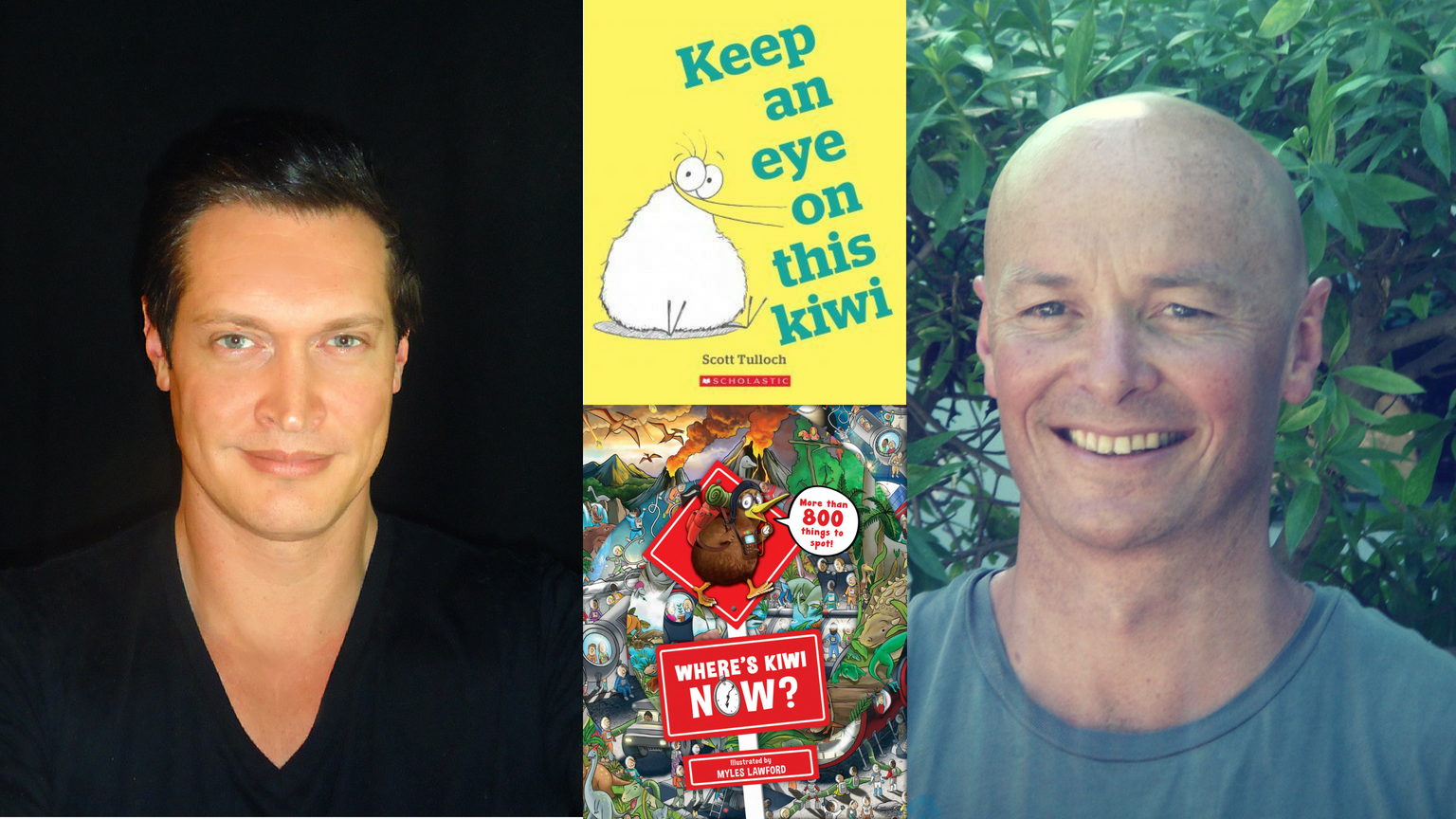
Scott Tulloch: I’ve just been looking through some of your books, and it’s the Where’s Kiwi? illustrations that really grab my attention.
There’s clearly a huge amount of work and planning in a book like this. How long did it take you to conceive, plan and create Where’s Kiwi? Did it involve long nights at the computer to get it finished on time?
Myles Lawford: Scholastic approached me with the idea of Where’s Kiwi I had no idea how much work was involved in creating a book of this type. There is a lot of research just to make sure each scene is factually accurate as possible, especially in the third book Where’s Kiwi Now? where I needed to get the fashions, environments and architecture right. I also didn’t want it to look like a Where’s Wally book.
Instead, I got my inspiration from a French illustrator, Jean-Jacques Loup but toned down his style so it was more child-friendly. The whole process took many months to complete. I enjoy the initial planning and trying to come up with interesting little scenes within each page so the children can keep coming back and discovering new things. .
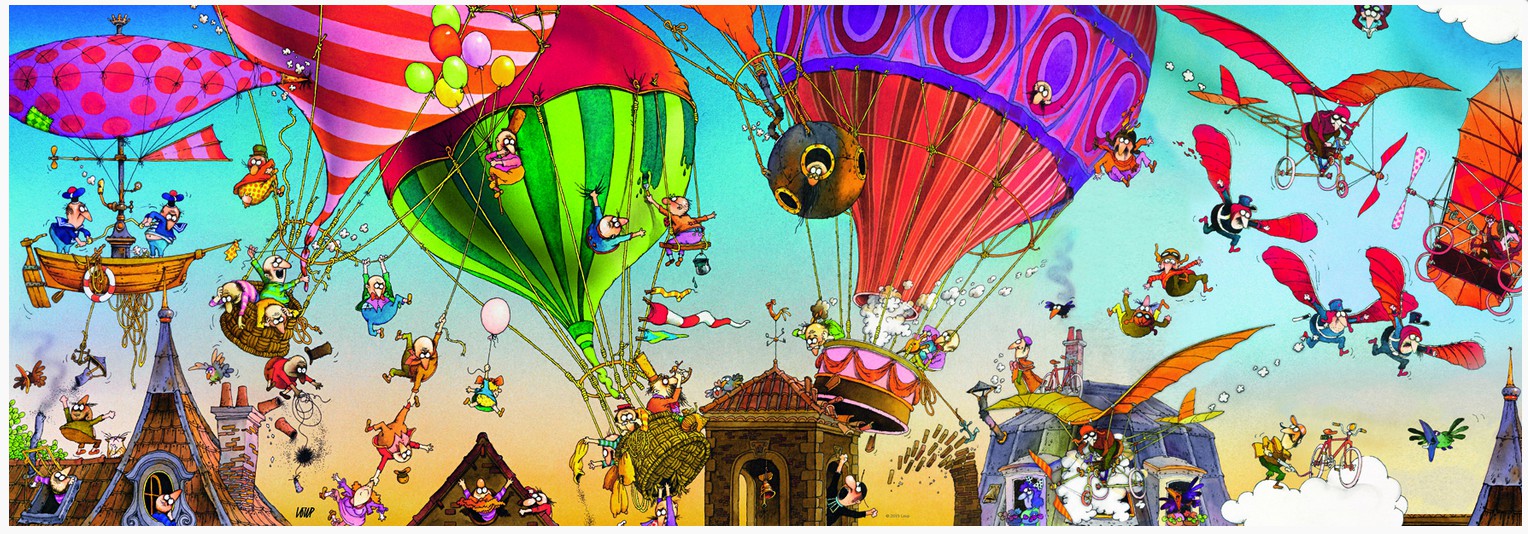
Blocking in colour and pushing the art to a near finished state is tedious, weeks and weeks of just colouring in hundreds and hundreds of little figures. But once that is over and you start to see it all come together my motivation and enthusiasm picks up again and it’s a dash to the finish aka deadline. It’s all worth it seeing the final product.
S: Comparing your work with my own, the obvious difference is that yours is digitally based and mine done by hand. Whenever I think of digital artwork I can’t help but think that I put myself at a working disadvantage by not embracing the technology. Do you think that working digitally confers advantages such as flexibility and speed, or is that simply not the case? Do you draw and paint by hand?
M: These books were all done digitally. It certainly helps when placing all the objects. I tend to move things around a lot until I’m satisfied I’ve made it challenging enough to find Kiwi and friends. Working digitally definitely has the advantage of speed but I always find my best illustrations are the ones that were hand drawn. So my typical process is to draw characters by hand for the initial concepts then scan them in to my computer to clean up and colour.
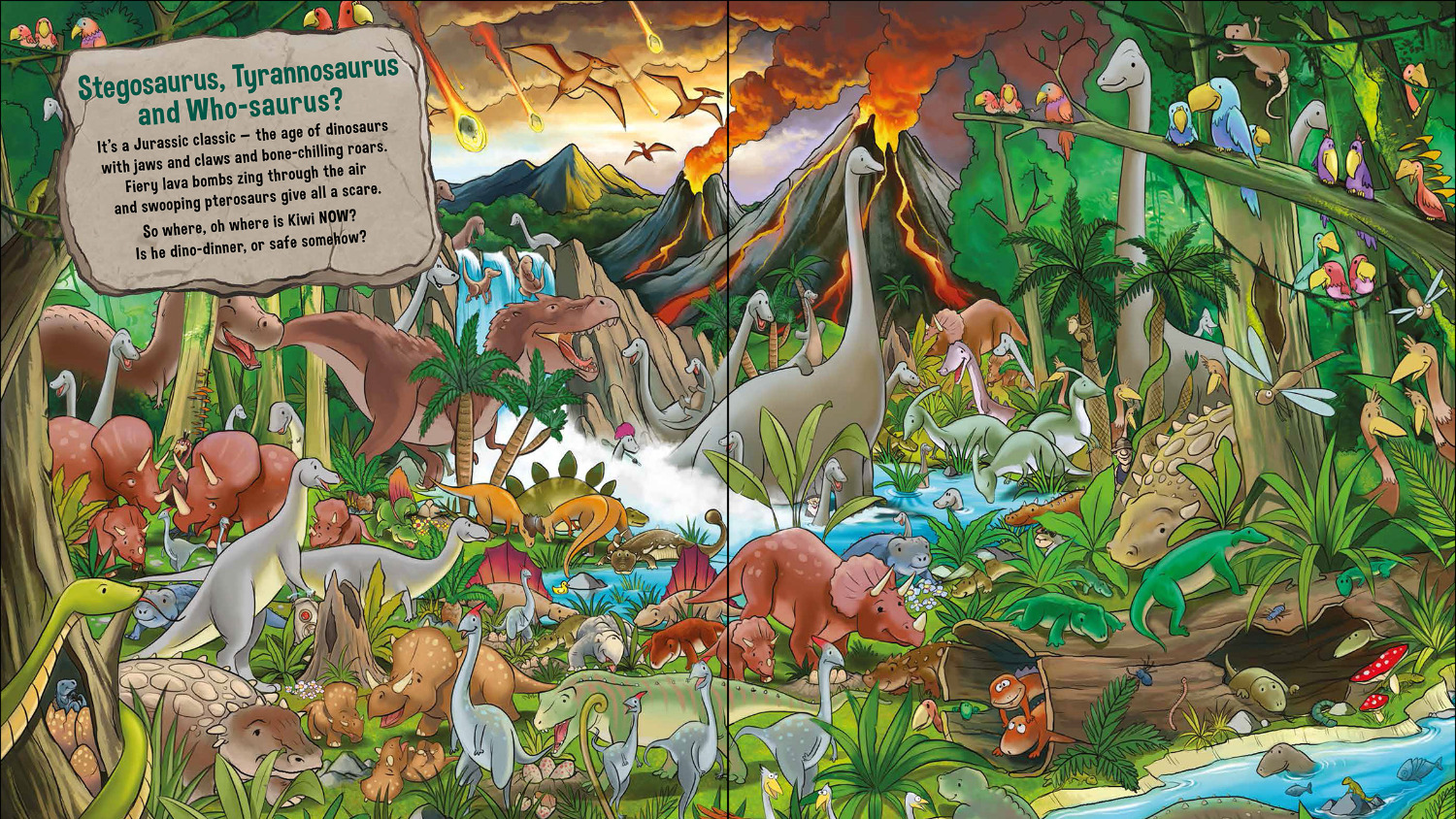
I enjoy drawing and painting by hand, I find it very therapeutic. I also like seeing the sketchy line work in illustrations – there is a warmth in the art. Whenever I see a lot of those old books created by Disney, I find them cold and too graphical.
M: Have you ever created a book digitally or tried the medium? What’s your main reason for sticking with traditional techniques?
S: I have tried my hand at digital illustration, very briefly. Some years ago I made the acquaintance of a graphic designer who had a spare computer with photoshop on it. He urged me to make use of it, and offered to give me some assistance in finding my way round the basics of digital illustration. In his opinion I was in danger of falling behind the times with my hand-drawn artwork. I did see the benefits of it, and was keen to develop a style which blended a hand-drawn look with the practical benefits of working digitally. However, the first digital sketch I submitted to Scholastic – the lead character for a book called Tom and the Dragon – was not well received. Scholastic asked me to do the book in pen and watercolour.
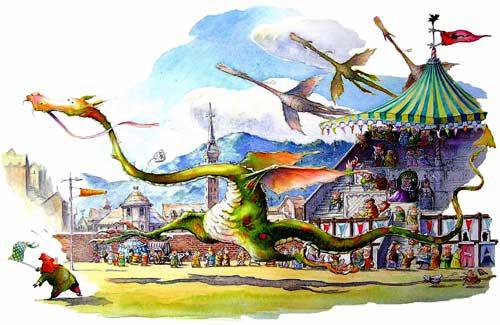
I pretty much stuck with what I knew from that point, illustrating in pencil, pen and watercolour, and more lately in gouache. I suppose you could say it’s inertia that has kept me illustrating by hand, as well as the cost of setting myself up with illustration software. I imagine it’s quite expensive.
And I do prefer the look of hand-drawn and painted illustrations generally, in particular those which blend of freedom and simplicity with good draughtsmanship, such as Emily Gravett, and those which show a real mastery of technique like the watercolours of David Wiesner.
S: So, Myles, you’re a great illustrator – how about writing? Any thoughts about writing your own stories? If you could have complete freedom to write and/or illustrate anything what would it be?
M: Actually yes, after illustrating books for the last 5 years I do feel like taking the next step. Still a long way to go. I have all these ideas floating around in my head – at one point I’m just going to sit down and commit to putting pen to paper. I think this is pretty normal for a creative to want to do their own thing.
I like stories of adventure, exploration and discovery. In the book The Lion, the Witch and the Wardrobe when they played hide and seek and found a wardrobe that took them to this fantasy land, as a child that story really fired up my imagination. I love stories which blend real life with something magical – Harry Potter, Charlie and the Chocolate Factory, those kind of stories.
I like stories of adventure, exploration and discovery.
Also it’s a case of how I want to create a book. I do like the style, format and length of your book Keep an eye on the Kiwi. As an illustrator I would try to create a book as graphical as possible, perhaps even a graphic novel but in a pocket size format. Honestly the more I think about this the more keen I am to attempt it. Thanks for the motivation!
M: What was the process in coming up with the Keep an eye on the Kiwi story? Were you influenced by anyone?
S: I wasn’t directly influenced by anyone in creating Keep an Eye on the Kiwi, but my main influences from a young age were Asterix books and Footrot Flats, and later on some of Raymond Briggs’ books, so the comic book/graphic novel style of writing has always been my favourite.
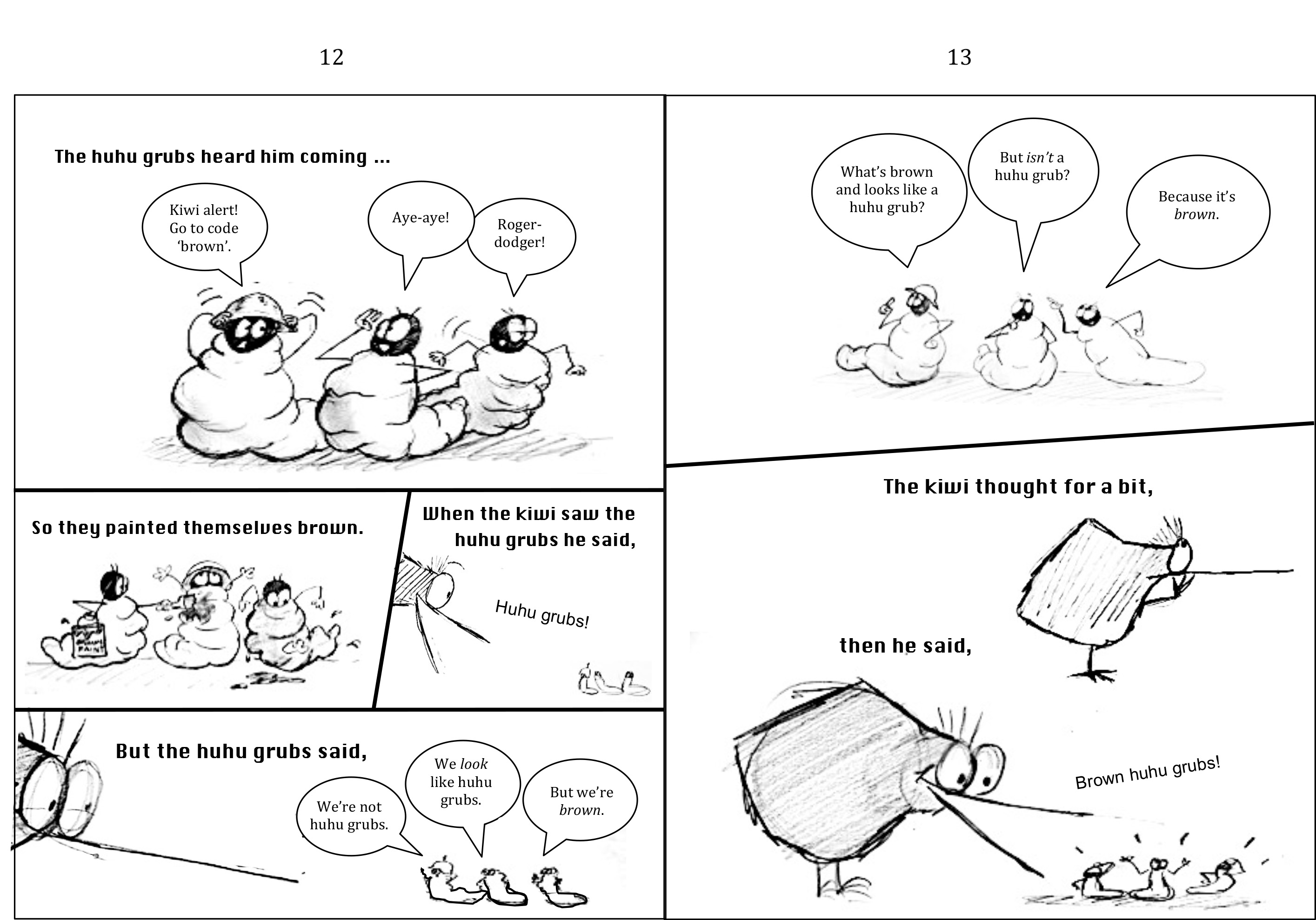
M: Oh yeah I loved Asterix and Footrot Flats, they were huge favourites of mine as well. Unlike today, back in the good old days the market wasn’t as saturated and most kids read the same few books in the school library. Horse was my favourite character by far, nobody messed with Horse.
S: Before I had my first book published I spent the whole of 2005 writing and drawing a 64 page, 500+ illustrations graphic novel called The Iceman. It was an action/thriller/mystery/comedy which included a little wee man with a genius for general knowledge called Godfrey Bennot, a pair of bickering policemen from the neighbouring arctic countries of Iceborg and Colslaw, a forensic pathology couple who resembled the man and woman from the American Gothic painting, Saami reindeer herders, sinister spyware, snow trolls, frost goblins, the woman of the woods, an abominable snowman with alopecia of the chin, Santa Claus and a Neanderthal.
Before I had my first book published I spent the whole of 2005 writing and drawing a 64 page, 500+ illustrations graphic novel called The Iceman.
This was the book I really wanted to see published, along with a few other graphic novel concepts including a wordless one about a young NZ farm boy who is shrunk to the size of an insect and discovers incredible mysteries and dangers on, in and under his “familiar” farming environment, and another one called Clan of the Cave Pig – also wordless – about the hapless travails of a prehistoric pig and his large family.
Keep an Eye on this Kiwi is, I suppose, a step towards edging myself back in the direction of the comic book format I always wanted to do. As for the process of writing it – it’s fair to say it’s a bit chaotic.
I suppose I start by thinking of the main character and his or her personality, then imagine a suitable protagonist. I’ll then try to think up funny or ridiculous scenarios, misunderstandings, back and forth exchanges etc that the different personalities might elicit from each other. As this develops I begin to get an idea for key moments in the story, and get a sense of where it might lead to in the end, and somehow end up with a plot of sorts.
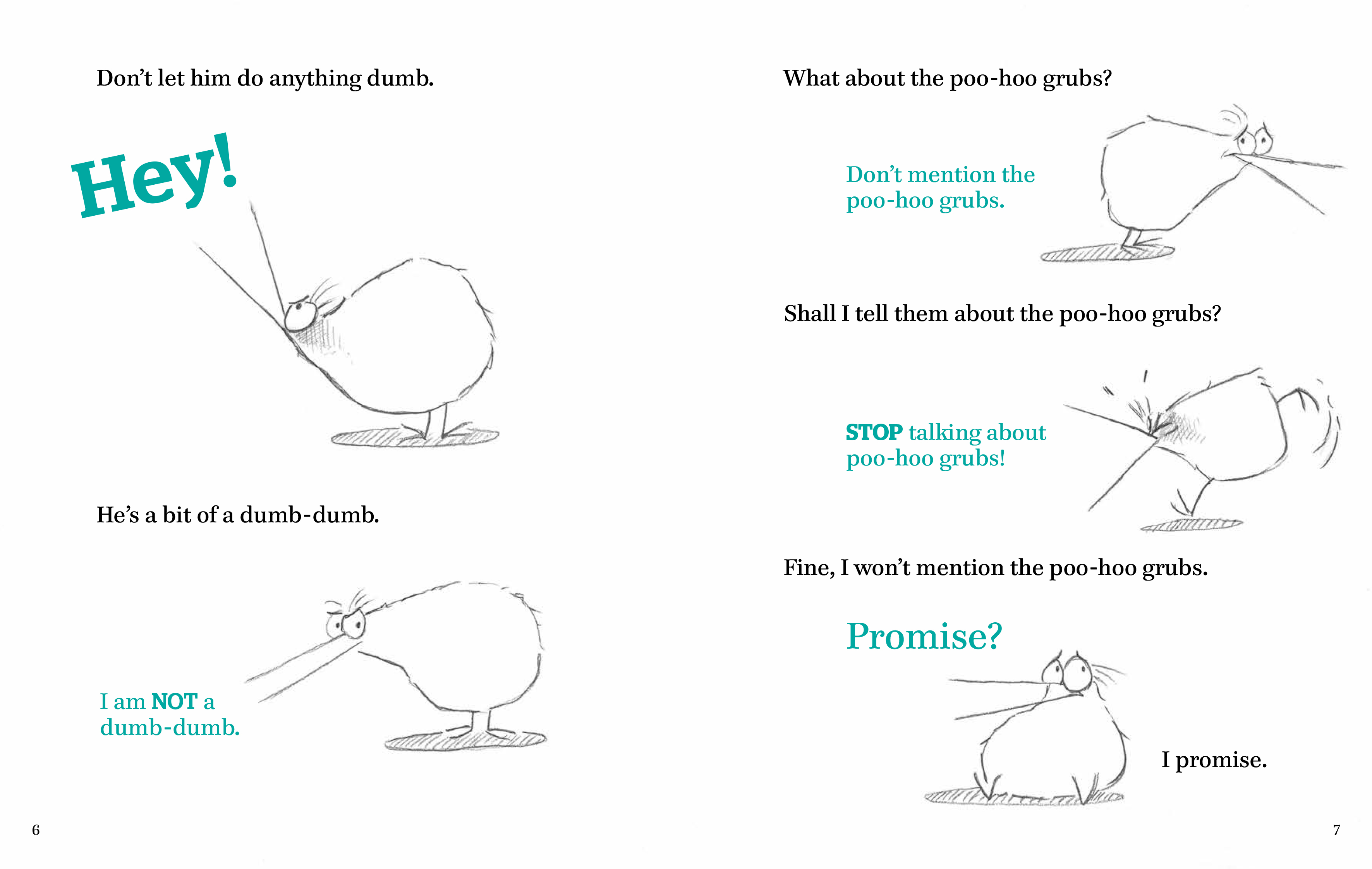
Once I’ve written and drawn the first draft from start to finish, I can then go back and rewrite it from finish to start and back again. Editing never seems to end, does it?
S: Out of interest, is art something you still can and do for pleasure, or do you find yourself drawn to other leisure pursuits to get away from what has now become your job?
M: I still try to keep up with my personal art but it becomes a struggle when you are spending all this time illustrating for others then to switch to illustrating for yourself. My background is Graphic Design so I still work in that field. Illustrating books is more of a side profession but I’m trying to make that transition where I can do it all the time because I enjoy it so much.
I find it extremely rewarding to create books. There was a moment when I walked into a bookstore and noticed this child sitting crossed legged in the aisle reading one of my books. That was a great moment and I had never felt that level of job satisfaction in all my years of being a Graphic Designer, and kids can be the toughest clients – they have no problem telling you if they don’t like the book.
There was a moment when I walked into a bookstore and noticed this child sitting crossed legged in the aisle reading one of my books. That was a great moment…
As a bit of my background story, I got degree in Design and then rushed out and started working in the Digital Media industry. It wasn’t until a client asked for a whole lot of children’s education material involving illustration that I realised this is what I wanted to do. He was my favourite client and I was happy to put everything aside to work on more illustrative work. So I took the risk and approached as many people as I could. Not many were interested in the digital style initially, but eventually Scholastic NZ gave me a chance.
M: So how did you get started in illustration?
S: The long way around! I desperately wanted to be a cartoonist/illustrator when I was ten, forgot all about it when I was fourteen, picked up the idea again at twenty-six, taught myself to draw, paint and sell artwork and became a professional artist until I was nearly forty.
In 2005, aged thirty-nine, I finally had a stab at writing and illustrating those graphic novels I mentioned earlier, submitted them (along with a heap of other picture book ideas) to every publisher in NZ and awaited the response. Within a week HarperCollins had contacted me and offered me a contract to publish my first book, Willy’s Dad, based on an idea I had about a serious little toddler and his juvenile father (autobiographical to a degree). From there it was just a matter of keeping going, one book at a time, until I’d more or less established myself.
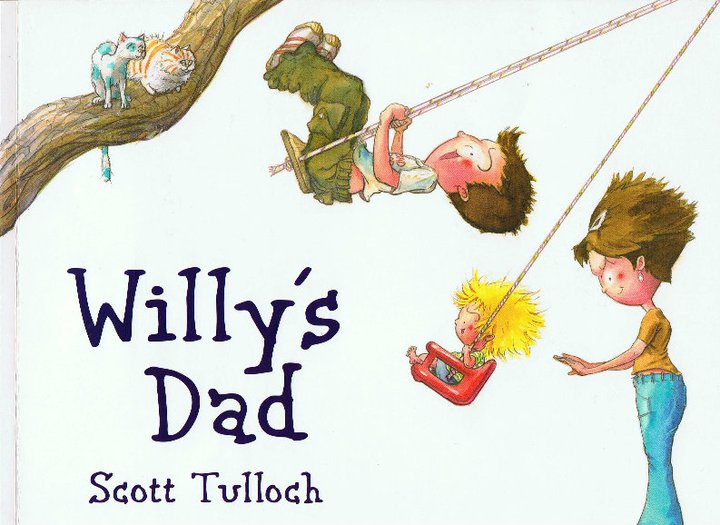
If it wasn’t for that initial response from HarperCollins I’m not sure how far along the road I’d be, because I waited in vain for all those other publishers to say “yes”!
Anyhow, I feel pretty lucky to be doing what I’m doing, and particularly grateful to Scholastic NZ who are now my main publisher, despite me butting heads with them over creative differences on a fairly frequent basis.
M: Ever thought of taking the risk and self-publishing the other book ideas you mentioned earlier? Though I know the costs of putting together a book isn’t small.
S: As for self-publishing, my main reason for not doing so isn’t actually the cost involved – it’s everything else. For years I was working for myself as a professional artist, which meant I was not simply painting but also framing, packaging, marketing and selling my artwork. I had my own gallery for several years, during which time I was essentially a shopkeeper. I hated it.
When I took the decision to become an author/illustrator it was with two key aspirations in mind. First and foremost, I wanted to create stories that really engaged people – lots of people – in a way individual paintings never can. And almost as importantly, I wanted someone else to do the printing, packaging, marketing and selling. All I really want to do is create. I can’t even keep my Facebook page up to date. Hopeless!
I wanted to create stories that really engaged people – lots of people – in a way individual paintings never can.
S: Righto, Myles, it’s been good talking to you. I hope we get to meet up some day soon. Anything you’d like to leave us with?
M: Yeah, I just wanted to say that even with all the gadgets, i-pods, phones etc which are now playing a major part in a child’s upbringing I still truly believe you can’t beat sitting down and reading a good book or being read a book.
It’s been very interesting hearing your perspective and journey. Thanks for getting in touch. Now I need to get started creating my own books.
S: Ditto. I spend hours on YouTube amusing, educating and entertaining myself, but I still can’t think of a better way to immerse myself than with a good book.
Scott Tulloch
Scott Tulloch is a self-taught New Zealand author and illustrator. He has illustrated more than 25 books, many of which are written by other New Zealand authors. However he particularly likes to write and illustrate his own books, using pictures as much as words to tell the story. His books often reflect his observations on the daftness of human behaviour.



